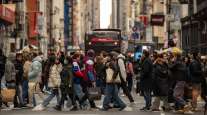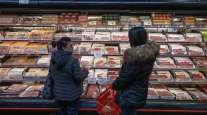Consumer Spending Rose 0.4% for a Second Month in June

Consumer purchases climbed a bit more than anticipated in June, exceeding a gain in incomes that prompted American households to tap into savings.
The 0.4% advance in spending followed a similar gain in the previous month, a Commerce Department report showed Aug. 2 in Washington. The median forecast in a Bloomberg News survey called for a 0.3% gain in consumption, which accounts for about 70% of the economy. Incomes rose a less-than-projected 0.2%, while the saving rate declined to a more than one-year low.
Purchases are broadening out beyond big-ticket items such as cars and houses as more Americans benefit from steady hiring, low inflation and cheap borrowing costs. The June figures underscore momentum heading into the third quarter after household spending grew in the previous three months by the most since 2014.
“The consumer is on a solid track,” said Thomas Simons, senior money-market economist in New York at Jefferies, which correctly projected the spending gain. “The momentum is going to continue into the third quarter and is fueled by strength in the labor market.”
The advance in purchases was led by a rebound in spending on durable goods and more outlays for services.
Gross domestic product expanded at a 1.2% annualized rate from April through June, less than projected after a first-quarter gain of 0.8% that was also lower than previously reported, Commerce Department data showed last week. Growth was driven by household purchases, which jumped 4.2%.
Projections for June consumer spending ranged from increases of 0.1% to 0.7%. The Bloomberg survey median for incomes called for a rise of 0.3%, after a 0.2% gain in May.
Disposable income, or the money left over after taxes, increased 0.1% after adjusting for inflation. It was little changed in the prior month.
The saving rate declined to 5.3%, the lowest since March 2015, from 5.5%. Wages and salaries advanced 0.3% following a 0.2% gain.
Adjusting consumer spending for inflation, which generates the figures used to calculate GDP, purchases rose 0.3% after a 0.2% increase in the previous month.
Among other details, household outlays on services rose 0.3% after adjusting for inflation. The category includes tourism, legal help, health care and personal care items such as haircuts and is typically difficult for the government to estimate accurately.
Spending on durable goods, which includes automobiles, increased 0.4% after adjusting for inflation. That followed a 0.1% drop. Spending on nondurable goods, which include gasoline, rose 0.3% for a second month.
The Federal Reserve’s preferred measure of inflation remained contained, the report showed. The price gauge based on the personal consumption expenditures index increased 0.1% from the prior month and was up 0.9% from a year earlier.




